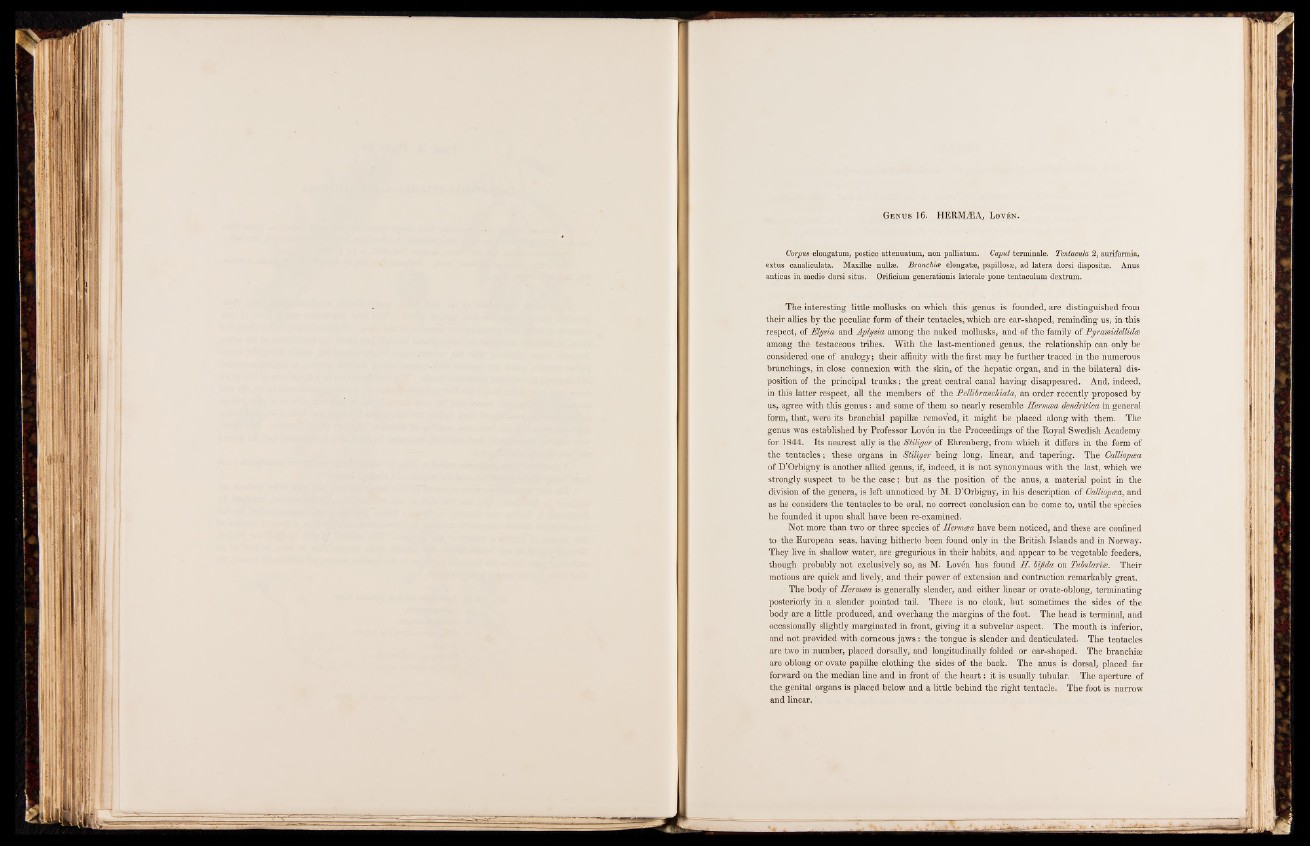
Genus 16. HERMCEA, Lovén.
Corpus elongatum, postice attenuatum, non palliatum. Caput terminale. Tentacula 2, auriformia,
extus canaliculata. Maxillae nullas. Branchia elongatae, papillosaa, ad latera dorsi dispositie. Anus
anticus in medio dorsi situs. Orificium generationis laterale pone tentaculum dextrum.
The interesting little mollusks on which this genus is founded, are distinguished from
their allies by the peculiar form of their tentacles, which are ear-shaped, reminding us, in this
respect, of JElysia and Aplysia among the naked mollusks, and of the family of Pyramidellidce
among the testaceous tribes. With the last-mentioned genus, the relationship can only be
considered one of analogy; their affinity with the first may be further traced in the numerous
branchings, in Close connexion with the skin, of the hepatic organ, and in the bilateral disposition
of the principal trunks; the great central canal having disappeared. And, indeed,
in this latter respect, all the members of the Pettibranchiata, an order recently proposed by
us, agree with this genus : and some of them so nearly resemble Hermcea dendritica in general
form, that, were its branchial papillae removed, it might be placed along with them. The
genus was established by Professor Loven in the Proceedings of the Royal Swedish Academy
for 1844. Its nearest ally is the Stiliyer of Ehrenberg, from which it differs in the form of
the tentacles; these organs in Stiliyer being long, linear, and tapering. The Calliopcea
of D’Orbigny is another allied genus, if, indeed, it is not synonymous with the last, which we
strongly suspect to be the case; but as the position of the anus, a material point in the
division of the genera, is left unnoticed by M. D’Orbigny, in his description of Calliopcea, and
as he considers the tentacles to be oral, no correct conclusion can be come to, until the species
he founded it upon shall have been re-examined.
Not more than two or three species of Hermcea have been noticed, and these are confined
to the European seas, having hitherto been found only in the British Islands and in Norway.
They live in shallow water, are gregarious in their habits, and appear to be vegetable feeders,
though probably not exclusively so, as M. Loven has found H. bifida on Tubular ice. Their
motions are quick and lively, and their power of extension and contraction remarkably great.
The body of Hermcea is generally slender, and either linear or ovate-oblong, terminating
posteriorly in a slender pointed tail. There is no cloak, but sometimes the sides of the
body are a little produced, and overhang the margins of the foot. The head is terminal, and
occasionally slightly marginated in front, giving it a subvelar aspect. The mouth is inferior,
and not provided with corneous jaws : the tongue is slender and denticulated. The tentacles
are two in number, placed dorsally, and longitudinally folded or ear-shaped. The branchiae
are oblong or ovate papillae clothing the sides of the back. The anus is dorsal, placed far
forward on the median line and in front of the h e a rt: it is usually tubular. The aperture of
the genital organs is placed below and a little behind the right tentacle. The foot is narrow
and linear.